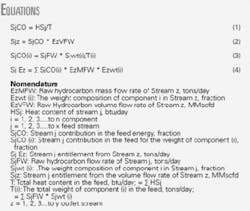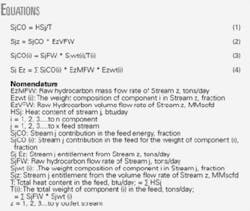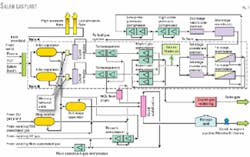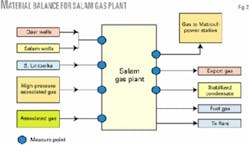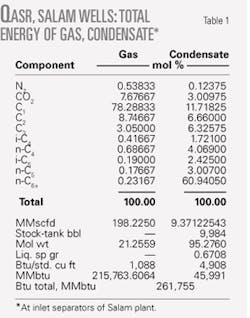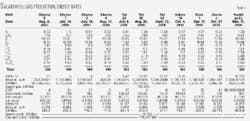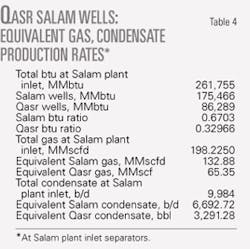This article reports on development of a methodology for the back-allocation of natural gas and condensate at natural gas processing facilities. This methodology is based on energy and weight balance equations that use gas and condensate compositions in the inlet and outlet streams.
A case study in Khalda Petroleum Co. confirms the applicability of this work. The new allocation system has proven reliable and is a comprehensive solution to meet the requirements of Khalda back-allocation process. The system provides capabilities to compute production on points where accurate measurements are not physically possible or economically practicable.
With natural gas production increasingly important to oil and gas companies in recent years, the problems of back-allocations to determine partners’ and owners’ shares of gas and condensate in the producing reservoirs have become more important. Several gas-balancing agreements are currently in use in the industry. Many of these agreements, however, fail to address adequately practical engineering problems encountered in balancing gas production.1-6
These problems include balancing of condensate production vs. balancing of gas production, owner’s imbalance at the time of acquisition or sale, and nomination and allocation to pipelines and purchasers.
Traditionally, allocation has been done primarily on the basis of energy content.7 8 This article, however, presents another methodology for allocation of the gas and condensate at natural gas processing plants, a methodology based on both energy and weight balance equations.
Equations
The energy-content method, or principle, of allocation is based on the fact that the petroleum industry is engaged in supplying energy in the form of heat.7 8 The heat content of liquid and gaseous fuels supplied is, to a large degree, the measure of the real value of the material.
The energy content is, therefore, a good measure of the intrinsic value of the hydrocarbons being produced. The energy-content method has the advantages of simplicity and stability because the constant ratio of heat content can be used as the measure of energy produced.
The product entitlements can be calculated according to the respective contribution in the feed streams. First, the feed streams, contribution is obtained according to Equation 1 (see accompanying equations box).
Then, the product entitlements for each stream can be calculated according to Equation 2.
The export point can be defined as the starting point for back-allocation at natural gas processing facilities because that is where an accurate production measurement is taking place. The product entitlements can be calculated according to the respective contribution in the feed streams.
First, the feed streams, contribution expressed in weight fraction for each component is obtained according to Equation 3.
Then, the product entitlements for each stream can be calculated according to Equation 4.
Salam gas plant
Khalda Western Desert Gas Development Project at Salam is in the western desert of Egypt, 70 km from Matrouh. The plant processes gas and condensate from five sources: Salam field wells, Qasr field wells, South Umbarka wells, and high-pressure gas and associated gas from a gas-oil separation plant.
The Salam gas plant produces about 200 MMscfd of export gas at an export pressure of 101 bara and 9,000 stock-tank bbl of condensate. The sales gas is designed to have a maximum CO2 content of 3.0%, maximum H2S content of 4 ppm (vol), heating value greater than 1,040 btu/std. cu ft, water dewpoint of less than 0.0º C. at 71 bara, and cricondentherm of 5º C. The condensate is designed for a maximum of 11 psi rvp.
As Fig. 1 shows, the gas from wells flows into two parallel trains. First it enters three-phase separator where the main water-condensate-gas separation takes places. The gas from the three-phase separators goes to a mercury-removal unit. Then, the gas flows to the glycol contactors to remove water from the gas to avoid hydrate formation and to achieve water dewpoint specifications.
Gas is then diverted to the dewpointing package whose function is to separate the entrained traces of condensate and the heavier hydrocarbon, which condensed as liquids from the gas at lower temperatures. This step is done to achieve the hydrocarbon dewpoint specifications using the turboexpanders.
After dewpointing, part of the gas (about 9 MMscfd) flows to the Matrouh power station before entering the membrane system of the sweetening process. Currently, this gas is discharged to the Matrouh power station at 37 bar, 40º C., and about 1,200 btu. The rest of the gas enters the gas-sweetening system (membrane package) to reduce the CO2 content of the export gas.
The final step is to export the gas in the export pipeline, matching previously stated specifications.
Condensate collected from the various processing steps is transferred to the stabilization step before being stored in the three storage tanks. Stabilization removes the light hydrocarbons to avoid release in the tanks and to achieve the rvp specification. This step is carried out in the stabilizer tower. Condensate is then shipped from the storage tanks via shipping pumps to El-Hamra.
Back-allocation for Salam
The following actual example for the Salam gas plant allocation illustrates application of the allocation procedure just described. Fig 2 presents the material-balance block diagram for the gas plant, showing every stream and measuring point involved.
At the plant’s inlet (Fig. 2) are connected the feed streams of Qasr and Salam wells. The gas or the condensate production rates for each field (Salam or Qasr) cannot be separately measured. The total gas and condensate rates of Salam and Qasr wells together, however, can only be measured with totalizers (198.225 MMscfd and 9,984 b/d).
Therefore, the first task in the calculations was to determine separately the gas and condensate production rates of Qasr and Salam at the inlet streams of the Salam plant using the energy-balance equations as described below.
1. Table 1 shows the calculation for the total energy of the gas and condensate produced from Qasr and Salam wells at the inlet separators of Salam plant. It is about 261,755 MMbtu.
2. Distribution of the gas and condensate production rates from natural Salam wells can be estimated with the results of the last production rate tests, as shown in Table 2.
3. Total energy of the gas and condensate produced from Salam wells can be calculated with the compositions data of the Salam wells, as shown in Table 3. It is about 175,466 MMbtu.
4. Total energy of the gas and condensate produced from Qasr wells can be calculated as (the result of Step 2 less the result of Step 1), 86,289 MMbtu.
5. The equivalent gas-condensate production rates of Qasr and Salam wells at the inlet separators of the Salam plant can be calculated, as shown in Table 4.
After all the inlet streams at the Salam plan are identified, the back-allocation for sharing gas and liquid produced from Salam gas plant is calculated on the basis of components, contributions in the inlet streams.
The data (gas-condensate flow rates and compositions) of the inlet streams (high-pressure gas, associated gas, Sumbarka gas, Qasr wells gas, and Salam wells gas) and the data of the outlet streams (gas to Mattrouh, export gas, fuel gas, flared gas, and condensate) along with the weight-balance equations were organized (with mole fractions of each stream) to determine the allocation of the gas and condensate.
Excel spreadsheets have been prepared for the weight-balance equations to perform this task. The products-entitlement summary report obtained from these spreadsheets can be presented as shown in Table 5.
null
Acknowledgments
The authors thank Khalda Petroleum Co. for permission to publish this article.
References
1. Charles, W.G., and Don, L.H., “Gas-Condensate Production and Allocation Prediction program,” SPE 3105, 45th Annual Fall Meeting of the Society of Petroleum Engineers of AIME, Houston, Oct. 4-7, 1970.
2. Daniel, L.S., and Kelkar, B.G., “Gas Balancing Between Working Interest Owners: An Engineer’s Perspective,” SPE 22619, 65th Annual Technical Conference and Exhibition of the Society of Petroleum Engineers, Dallas, Oct. 6-9, 1991.
3. McConnell, J.D., “Remote Gas Measurement for Production Allocation: Douglas Creek Arck Region,” SPE 20644, 65th Annual Technical Conference and Exhibition of the Society of Petroleum Engineers, New Orleans, Sept. 23-26, 1990.
4. E1-Massry, Y.A., and Price, A.D., “Development of a Network and Gas Lift Allocation Model for Production Optimization in the Ras Budran Field,” SPE 29782, SPE Middle East Oil Show, Manama, Bahrain, Mar. 11-14, 1995.
5. Gerardo, L.B., Dutta-Roy, K., and Cetin, O., “Integrated Compositional Surface-Subsurface Modeling for Rate Allocation Calculations,” SPE 74382, SPE International Petroleum Conference and Exhibition, Villahermosa, Mexico, Feb. 10-12, 2002.
6. Marwan, H., Satheesh, S., and Ali, A., “Back Allocation System with Network Visualization,” SPE 88747, 11th Abu Dhabi International Petroleum Conference and Exhibition, Abu Dhabi, Oct. 10-13, 2004.
7. Hunter, E.E., “Allocation of Costs between Petroleum Liquids and Gases,” SPE 292-G, Petroleum Branch Fall Meeting, Dallas, Oct. 19-21, 1953.
8. Telesford, A.L., “Value-Based Allocation and Value Adjustment on Mixed-Quality Commingled Natural Gas Pipelines,” 2005 SPE Annual Technical Conference and Exhibition, Dallas, Oct. 9-12, 2005.
The authors
Mahmoud Abu El Ela ([email protected]) is an assistant professor in the Petroleum Engineering Department, Cairo University, and also works as a petroleum process consulting engineer at Khalda Petroleum Co. He previously worked as a research engineer at Woodside Research Foundation, Curtin University of Technology-Australia. Abu El Ela holds a BSc and MSc in petroleum engineering from Cairo University (Egypt) and a PhD from Curtin University of Technology (Australia). He is a member of the Egyptian Engineers Syndicate and SPE.
Ismail Mahgoub is chairman of Khalda Petroleum. He previously served as chairman for Petrozeit Co., operations general manager for Khalda Petroleum, assistant general manger for Wepco Petroleum Co., and associate professor for Cairo University. Mahgoud holds a BSc in petroleum engineering from Cairo University (Egypt) and a PhD from Institut National Polytechnique de Lorraine, Nancy, France. He is a member in the Egyptian Engineers Syndicate and SPE.
Mostafa Nabawi is a general manager in the gas operation department at Khalda Petroleum. He previously worked as assistant general manager in the gas operation department at Khalda Petroleum. Nabawi holds a BSc in mechanical engineering from Assuit University, Egypt. He is a member in the Egyptian Engineers Syndicate and SPE.
Mohamed Abdel Aziem is an assistant general manager in the gas operation department at Khalda Petroleum. He holds a BSc in petroleum engineering from El Azhar University, Cairo. He is a member in the Egyptian Engineers Syndicate and SPS.
